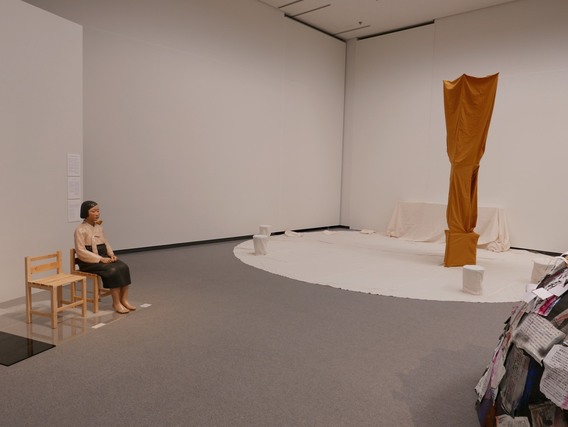Aichi Triennale to Reopen Controversial Exhibition
By HG Masters

Installation view of
The exhibition “After ‘Freedom of Expression?’”, part of the Aichi Triennale 2019, will reopen at the Aichi Prefectural Museum of Art in Nagoya with all the controversial artworks on view, after it was closed in early August. On Monday September 30, the Aichi Triennale organization and the Aichi Prefectural Museum of Art in Nagoya reached an agreement at Nagoya District Court. The display will be accessible again to the public starting between October 6 and October 8, until the end of the festival on October 14. As part of the settlement, Aichi Governor Hideaki Omura, the chairperson of the Triennale’s steering committee, required Triennale organizers to comply with added security measures and to establish an advanced reservations system.
The Aichi Triennale 2019 is titled “Taming Y/our Passion” and directed by Daisuke Tsuda. “After ‘Freedom of Expression?’” was a small display of previously censored artworks in Japan, about topics ranging from the depiction of the Japanese emperor, comfort women, United States military bases, the Fukushima nuclear disaster, and other sensitive topics. The sculpture of a Korean “comfort woman,” Statue of Peace (2011), by Kim Seo-kyung and Kim Eun-sung, attracted nationalist ire from local politicians, including the Nagoya City mayor Takashi Kawamura, and the Triennale received anonymous threats of violence. The artwork depicts a seated woman symbolizing the estimated 200,000 women in Korea, China, and across Asia who were forced to serve as prostitutes, or ianfu, in Japanese World War II brothels. Diplomatic ties and trade relations between Japan and South Korea hit a nadir in July, as the far-right-wing administration of Shinzo Abe in Japan continues to deny that the Imperial Japanese Army enslaved workers during its occupation of the Korean peninsula between 1910–45, or that Korean women were forced to work in brothels.
After the exhibition was closed, Minouk Lim and Park Chan-kyong, both from South Korea, withdrew their artworks, and more than 70 participating artists condemned the closure of the exhibition. Later in August, several other participating artists, including Tania Bruguera and Javier Téllez had closed their installations, and other artists altered their artworks to indicate their disapproval of the Triennale’s decision. On September 25, an independent committee hosted by the prefectural government and headed by Toshio Yamanashi, director of the National Museum of Art, Osaka, recommended that the exhibition been resumed as soon as conditions allowed.
On September 26, the Agency for Cultural Affairs, a special body of the Japanese Ministry of Education, Culture, Sports, Science and Technology, also withdrew its grant of JPY 78 million (USD 722,00) to the Triennale, allegedly on the grounds that the Aichi government did not provide necessary information in its application for the subsidy. The Education Minister Koichi Hagiuda denied that the agency’s withdrawal of funding was due to the presence of Statue of Peace. On September 26, Aichi Governor Hideaki Omura announced he intends to sue the ministry over its withdrawal of funding.
Additionally, on September 29, the Aichi Triennale Next Step Committee and Aichi Triennale Organizing Committee announced the agenda for the joint Aichi Triennale 2019 International Forum, “Freedom of Expression and Art in ‘Taming Y/Our Passion’,” a two-day event on October 5–6 at the Aichi Arts Center in Nagoya, where academics, journalists, artists, and the Aichi Triennale curators as well as international curators who have worked in the region, Jörg Heiser (2018 Busan Biennale) and Cuauhtémoc Medina (2019 Shanghai Biennale), will speak on issues of freedom of expression.
HG Masters is the deputy editor and deputy publisher of ArtAsiaPacific.







